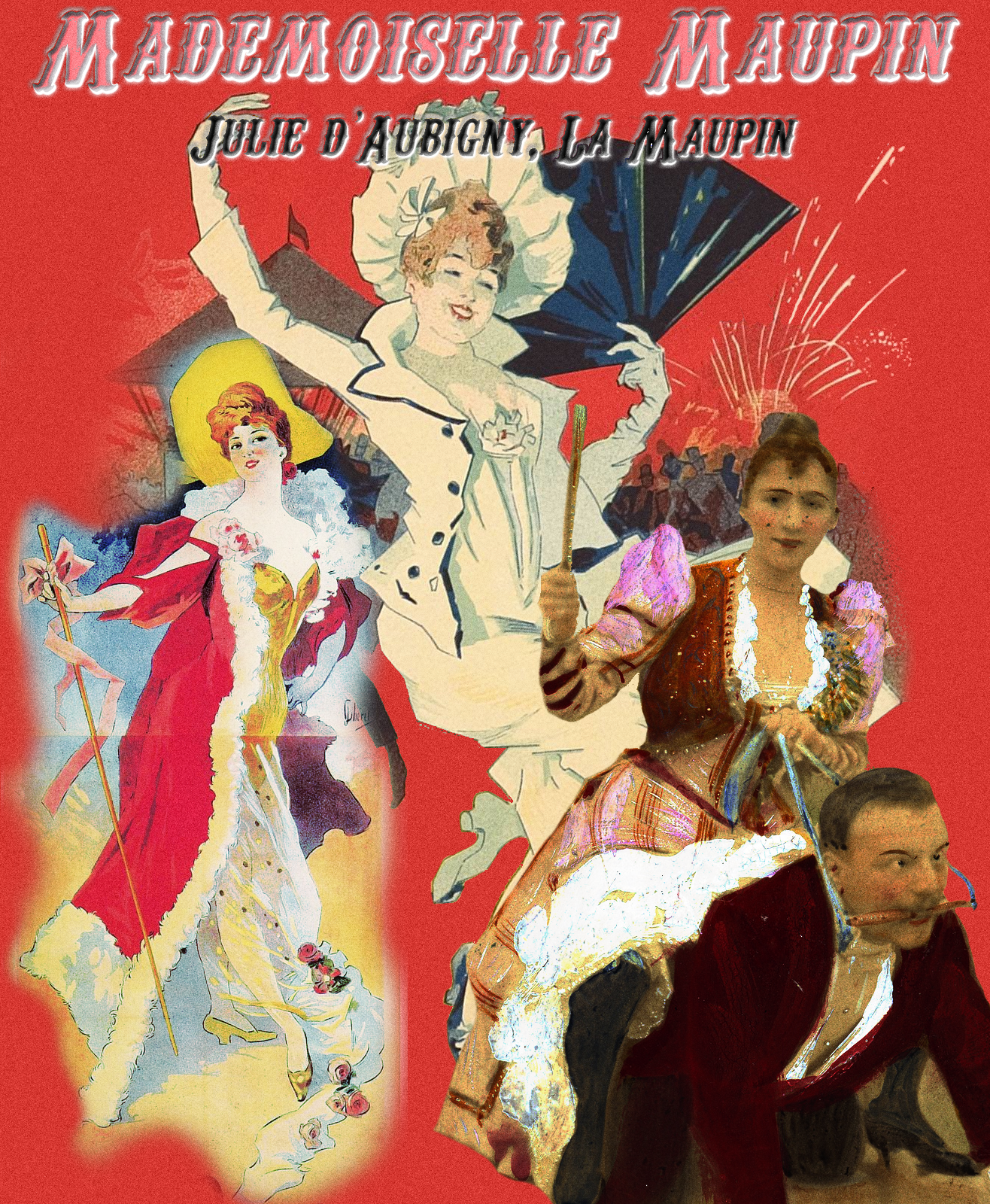Today's entry in Mythological Figures is another historical figure that’s taken hold of some zeitgeist and earned a place in today's popular culture. Julie D'Aubigny ("La Maupin") started appearing on social media last year and for good reason--she was a straight up badass.

Many of us have seen one of the memes or articles article so I’ll keep it short:
Mademoiselle Maupin’s habit and talent for winning duels (and singing like a champ when she wasn’t on the run from the law for beating people up) continued until she found true love, her paramour perished, and she shuffled off her own mortal coil at the age of just 33.
As ever the list of Mythological Figures is open to more entries so tell us who you want to see get a statblock!
Julie d'Aubigny (La Maupin, Mademoiselle Maupin)
Medium humanoid (human), chaotic good rogue (duelist) 9/fighter (master of battle) 7
Armor Class 16 (padded armor)
Hit Points 111 (9d8+7d10+32)
Speed 30 ft.
Saving Throws Dex +10, Int +6
Skills Athletics +7, Deception +13, Insight +5, Perception +10, Performance +13, Persuasion +13
Senses passive Perception 20
Languages English, French, German, Italian
Challenge 10 (5,900 XP)
Background: Virtuoso. La Maupin is never without a stage or room to sing for entertainment whether in a queen’s castle or a tavern. She receives free accommodations (including a room and meal) each night she performs and is recognized while going about a settlement where she’s sung at least one evening (and is typically well-liked for her vocal talents).
Action Surge (1/short rest). On her turn, La Maupin can take an additional action on top of her regular action and a possible bonus action.
Cunning Action. La Maupin can take a bonus action on each of her turns in combat. This action can be used only to take the Dash, Disengage, or Hide action.
Duelist’s Edge. La Maupin has a +3 bonus to initiative rolls.
Evasion. When La Maupin is subjected to an effect that allows her to make a Dexterity saving throw to take only half damage, she instead takes no damage if she succeeds on the saving throw, and only half damage if she fails.
Maneuver Master (5d8 maneuver dice/short rest). La Maupin can expend a maneuver dice to perform a single maneuver with an attack.
Martial Footing. When La Maupin makes a melee attack against a creature on her turn, she does not provoke opportunity attacks from it until the end of her turn.
Rakish Edge. La Maupin can use an action to make a Charisma (Persuasion) check opposed by a Wisdom (Insight) check from a creature able to hear and understand her. On a success, for 1 minute creatures other than La Maupin do not provoke opportunity attacks from the target and the target has disadvantage on attack rolls against anyone but her. The effect ends if a creature other than La Maupin attacks the target or until she is more than 60 feet away from the target. When La Maupin uses this feature on a creature that is not hostile, the target is charmed for 1 minute or until she or her companions harm it.
Second Wind (1/short rest). On her turn, La Maupin can use a bonus action to regain 1d10+7 hit points.
Sneak Attack (1/turn). La Maupin deals an extra 31 (9d6) damage when she hits a target with a weapon attack and has advantage on the attack roll, or when the target is within 5 feet of an ally of La Maupin that isn’t incapacitated and she doesn’t have disadvantage on the attack roll. La Maupin also deals her Sneak Attack damage if the only creature within 5 feet of her is the target of her attack and she doesn’t have disadvantage on the attack roll.
ACTIONS
Extra Attack. La Maupin attacks twice.
Rapier. Melee Weapon Attack: +10 to hit, reach 5 ft., one target. Hit: 11 (1d8+7) piercing damage.
Dagger. Melee or Ranged Weapon Attack: +10 to hit, reach 5 ft. or range 20/40 ft., one target. Hit: 7 (1d4+5) piercing damage.
Hand Crossbow. Ranged Weapon Attack: +10 to hit, range 30/120 ft., one target. Hit: 8(1d6+5) piercing damage.
REACTIONS
Uncanny Dodge. When an attacker La Maupin can see hits her with an attack, she can use her reaction to halve the attack’s damage against her.
Many of us have seen one of the memes or articles article so I’ll keep it short:
- Went around on the run with a fencing buddy and made it as a traveling minstrel (who crossdressed in men’s clothing, though never claiming to be a man). She was so good she joined the opera from here.
- I’m just going to quote the wikipedia page on this one because wow:
Eventually, she grew bored of Sérannes and became involved with a young woman. When the girl's parents put her away in the Visitandines convent in Avignon, La Maupin followed, entering the convent as a postulant. In order to run away with her new love, she stole the body of a dead nun, placed it in the bed of her lover, and set the room on fire to cover their escape…La Maupin was charged in absentia—as a male—with kidnapping, body snatching, arson, and failing to appear before the tribunal. The sentence was death by fire.
- Naturally she went back to singing on the road. Before too long she gets insulted by a young nobleman, duels him and wounds him, then visits him and they became lovers (and lifelong buddies).
- Still a fugitive, her incredible singing talents get her a pardon so she can perform in the Paris Opera.
Mademoiselle Maupin’s habit and talent for winning duels (and singing like a champ when she wasn’t on the run from the law for beating people up) continued until she found true love, her paramour perished, and she shuffled off her own mortal coil at the age of just 33.
As ever the list of Mythological Figures is open to more entries so tell us who you want to see get a statblock!
Julie d'Aubigny (La Maupin, Mademoiselle Maupin)
Medium humanoid (human), chaotic good rogue (duelist) 9/fighter (master of battle) 7
Armor Class 16 (padded armor)
Hit Points 111 (9d8+7d10+32)
Speed 30 ft.
| STR | DEX | CON | INT | WIS | CHA |
| 14 (+2) | 20 (+5) | 14 (+2) | 12 (+1) | 10 (+0) | 16 (+3) |
Skills Athletics +7, Deception +13, Insight +5, Perception +10, Performance +13, Persuasion +13
Senses passive Perception 20
Languages English, French, German, Italian
Challenge 10 (5,900 XP)
Background: Virtuoso. La Maupin is never without a stage or room to sing for entertainment whether in a queen’s castle or a tavern. She receives free accommodations (including a room and meal) each night she performs and is recognized while going about a settlement where she’s sung at least one evening (and is typically well-liked for her vocal talents).
Action Surge (1/short rest). On her turn, La Maupin can take an additional action on top of her regular action and a possible bonus action.
Cunning Action. La Maupin can take a bonus action on each of her turns in combat. This action can be used only to take the Dash, Disengage, or Hide action.
Duelist’s Edge. La Maupin has a +3 bonus to initiative rolls.
Evasion. When La Maupin is subjected to an effect that allows her to make a Dexterity saving throw to take only half damage, she instead takes no damage if she succeeds on the saving throw, and only half damage if she fails.
Maneuver Master (5d8 maneuver dice/short rest). La Maupin can expend a maneuver dice to perform a single maneuver with an attack.
- Counter. La Maupin uses her reaction to make a melee attack against a creature that misses her with a melee attack, dealing 1d8 additional damage on a hit.
- Disarm. A creature La Maupin has hit with a melee attack takes 1d8 additional damage and makes a DC 18 Strength saving throw or drops one held item of her choice
- Feint. La Maupin can use her bonus action to feint against one creature within 5 feet. She has advantage on her next attack roll against that creature as long as it made is before the end of her turn. On a hit she deals 1d8 additional damage.
- Lunge. La Maupin increases her reach by 5 feet for one attack, dealing 1d8 additional damage on a hit.
- Menace. On a successful hit with a melee weapon, La Maupin deals 1d8 additional damage and the target makes a DC 18 Wisdom saving throw or is frightened of her until the end of La Maupin’s next turn.
Martial Footing. When La Maupin makes a melee attack against a creature on her turn, she does not provoke opportunity attacks from it until the end of her turn.
Rakish Edge. La Maupin can use an action to make a Charisma (Persuasion) check opposed by a Wisdom (Insight) check from a creature able to hear and understand her. On a success, for 1 minute creatures other than La Maupin do not provoke opportunity attacks from the target and the target has disadvantage on attack rolls against anyone but her. The effect ends if a creature other than La Maupin attacks the target or until she is more than 60 feet away from the target. When La Maupin uses this feature on a creature that is not hostile, the target is charmed for 1 minute or until she or her companions harm it.
Second Wind (1/short rest). On her turn, La Maupin can use a bonus action to regain 1d10+7 hit points.
Sneak Attack (1/turn). La Maupin deals an extra 31 (9d6) damage when she hits a target with a weapon attack and has advantage on the attack roll, or when the target is within 5 feet of an ally of La Maupin that isn’t incapacitated and she doesn’t have disadvantage on the attack roll. La Maupin also deals her Sneak Attack damage if the only creature within 5 feet of her is the target of her attack and she doesn’t have disadvantage on the attack roll.
ACTIONS
Extra Attack. La Maupin attacks twice.
Rapier. Melee Weapon Attack: +10 to hit, reach 5 ft., one target. Hit: 11 (1d8+7) piercing damage.
Dagger. Melee or Ranged Weapon Attack: +10 to hit, reach 5 ft. or range 20/40 ft., one target. Hit: 7 (1d4+5) piercing damage.
Hand Crossbow. Ranged Weapon Attack: +10 to hit, range 30/120 ft., one target. Hit: 8(1d6+5) piercing damage.
REACTIONS
Uncanny Dodge. When an attacker La Maupin can see hits her with an attack, she can use her reaction to halve the attack’s damage against her.

